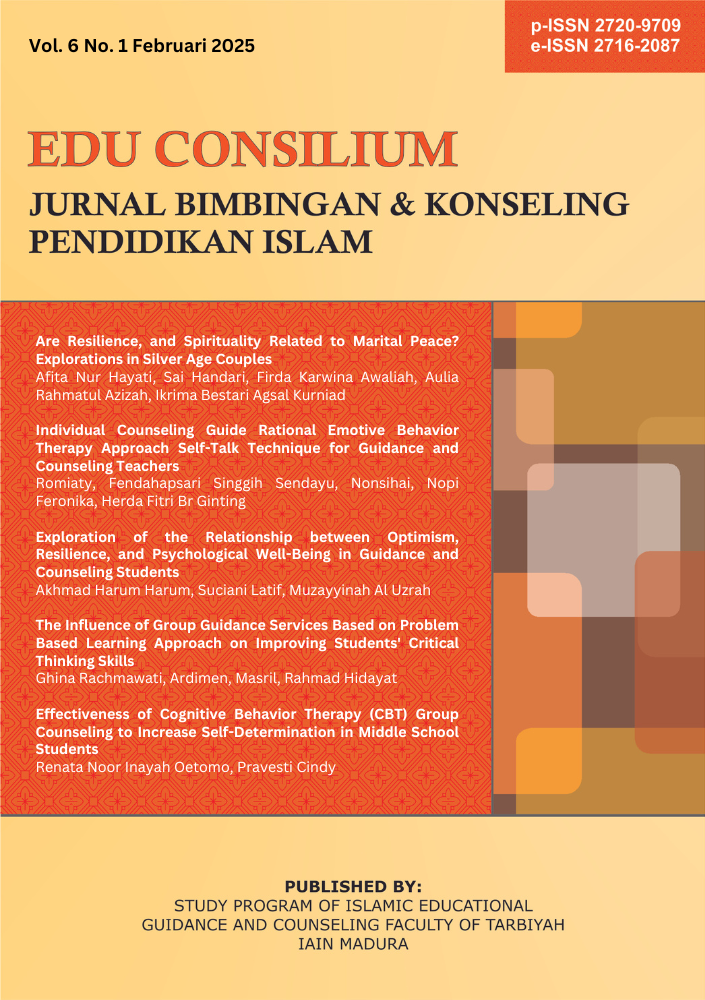Post-Divorce Adjustment in Divorced Madurese Women
 Abstract views: 99
,
Abstract views: 99
,
 PDF downloads: 112
PDF downloads: 112
Abstract
The prevalence of divorce in Madurese society has increased in recent years, and the party that feels the most impact of divorce is women. This study aims to explain the adjustment of Madurese women after divorce. This study uses a qualitative method with a Phenomenological approach. Data collection used in-depth interview techniques involving 13 Madurese women who had divorced. Data were analyzed using the Interpretative Phenomenological Analysis (IPA) technique which involved eight stages of data analysis. Data credibility was carried out using the member check technique. The results of the study showed two themes, namely emotional dynamics and post-divorce adjustment in Madurese women. The emotional dynamics of divorced Madurese women include loneliness, sadness, hopeless, disappointment, regret, pessimism, and relief. Meanwhile, the post-divorce adjustment process that they do includes seeking social support, busying themselves with various activities, getting closer to God through prayer and worship, trying to divert memories, regulating emotions, and rebuilding self-confidence. This study is useful for Madurese women as a basis or guideline in making adjustments after divorce. It is also important to understand that the role of close people can contribute greatly to helping divorced women adjust.
Downloads
References
Asanjarani, F., Jazayeri, R. S., Fatehizade, M., Etemadi, O., & Demol, J. (2017). Exploring factors affecting post-divorce adjustment in Iranian women: A qualitative study. Social Determinants of Health, 3(1), 15–25. https://doi.org/10.22037/sdh.v3i1.17705
Borgmann, L.-S., Rattay, P., & Lampert, T. (2018). Single parents in germany: The interrelation between social support and mental health. Das Gesundheitswesen. doi:10.1055/a-0652-5345
BPS. (2021). Nikah dan cerai menurut Kabupaten/Kota di Provinsi Jawa Timur, 2021. Diakses pada tanggal 19 Februari 2023 dari https://www.bps.go.id/indikator/indikator/view_data_pub/3500/api_%20pub/VHpUK3MrOVd6dTJjcHdoQ1Z6TGlmUT09/da_04/1
BPS. (2022). Jumlah Talak dan Cerai Menurut Kabupaten/Kota di Provinsi Jawa Timur, 2020-2022. Diakses pada tanggal 15 Januari 2024 dari https://jatim.bps.go.id/id/statistics-table/1/MzAyOSMx/jumlah-talak-dan-cerai-menurut-kabupaten-kota-di-provinsi-jawa-timur--2020-2022.html
Cherlin, A., Cross-Barnet, C., Burton, L. M., & Garrett-Peters, R. (2008). Promises they can keep: Low-income women’s attitudes toward motherhood, marriage, and divorce. Journal of Marriage and Family, 70(4), 919–933. doi:10.1111/j.1741-3737.2008.00536.x
Elisetty, S, G., & Datti, R. S. (2025). Research trends on the intricate dimensions of divorce among women: A bibliometric analysis. Women's Studies International Forum, 108, 103028, 1-10. https://doi.org/10.1016/j.wsif.2024.103028
Gallagher, M. (2002). What is marriage for? the public purpose of marriage law. Lousiana Law Review, 62(3), 773-791
Halford, W. K., & Sweeper, S. (2012). Trajectories of Adjustment to Couple Relationship Separation. Family Process, 52(2), 228–243. doi:10.1111/famp.12006
Kahija, L. (2017). Penelitian fenomenologis: Jalan memahami pengalaman hidup. PT Kanisius.
Kołodziej-Zaleska, A., & Przybyła-Basista, H. (2016). Psychological well-being of individuals after divorce: The role of social support. Current Issues in Personality Psychology, 4(4), 206–216.
Koppejan-Luitze, H. S., van der Wal, R. C., Kluwer, E. S., Visser, M. M., & Finkenauer, C. (2021). Are intense negativeemotions a risk for complexdivorces? An examinationof the role of emotionsin divorced parents and co-parenting concerns. Journal of Social and Personal Relationships, 38(2), 765-782. https://doi.org/10.1177/0265407520972189
Krumrei, E., Coit, C., Martin, S., Fogo, W., & Mahoney, A. (2007). Post-divorce adjustment and social relationships. Journal of Divorce & Remarriage, 46(3-4), 145–166. doi:10.1300/j087v46n03_09
Lawson, E. J., & Satti, F. (2016). The aftermath of divorce: Postdivorce adjustment strategies of south asian, black, and white women in the united states. Journal of Divorce & Remarriage, 57(6), 411–431. doi:10.1080/10502556.2016.1196849
Leopold, T. (2018). Gender differences in the consequences of divorce: A study of multiple outcomes. Demography, 55(3), 769–797. doi:10.1007/s13524-018-0667-6
Lu, Y.-C., Walker, R., Richard, P., & Younis, M. (2019). Inequalities in poverty and income between single mothers and fathers. International Journal of Environmental Research and Public Health, 17(1), 135. doi:10.3390/ijerph17010135
Molina, O. (2000). African american women’s unique divorce experiences. Journal of Divorce & Remarriage, 32(3-4), 93–99. doi:10.1300/j087v32n03_05
Odis, A. I. (2021). Effects of divorce on women and children. Texila International Journal of Public Health, 1-14. DOI 10.21522/TIJPH.2013.09.01.Art001
Ozbek, S. K., & Demir, M. (2022). The Effectiveness of the Post-divorce Psychological Support Program (PDPSP) on Divorced Individual Adjustment Levels: A Pilot Study at Women. International Journal of Psychology and Educational Studies, 9(3), 602-618.
Qamar, A. H., & Faizan, H. F. (2021). Reasons, impact, and post-divorce adjustment: Lived experience of divorced women in Pakistan. Journal of Divorce & Remarriage, 62(5), 349–373. doi:10.1080/10502556.2021.1871840
Raley, R. K., & Sweeney, M. M. (2020). Divorce, repartnering, and stepfamilies: A decade in review. Journal of Marriage and Family, 82(1), 81–99. doi:10.1111/jomf.12651
Ridgway, A. (2022). “I had faith”: Migrant women’s use of religion and spirituality to reframe their divorce and for self- reinvention. Journal of Divorce and Remarriage, 63(4), 298–317. https://doi.org/10.1080/10502556.2022.2048346
Scott, E. S. (2004). Marriage, cohabitation and collective responsibility for dependency. University of Chicago Legal Forum, 7(1), 225-264.
Smith, J. A., Flowers, P., & Larkin, M. (2009). Interpretative phenomenological analysis: Theory, method, and research. Sage Publications Ltd.
Steiner, L. M., Suarez, E. C., Sells, J. N., & Wykes, S. D. (2011). Effect of age, initiator status, and infidelity on women’s divorce adjustment. Journal of Divorce & Remarriage, 52(1), 33–47. doi:10.1080/10502556.2011.534394
Smock, P. J., Manning, W. D., & Gupta, S. (1999). The effect of marriage and divorce on women’s economic well-being. American Sociological Review, 64(6), 794. doi:10.2307/2657403
Strizzi, J. M., Ciprić, A., Sander, S., & Hald, G. M. (2021). Divorce is stressful, but how stressful? perceived stress among recently divorced danes. Journal of Divorce & Remarriage, 62(4), 295–311. doi:10.1080/10502556.2021.1871838
Treloar, R. (2019). Parents making meaning of high-conflict divorce. Australian and New Zealand Journal of Family Therapy. doi:10.1002/anzf.1347
Widan, R. J., & Greeff, A. P. (2019). Aspects of social support associated with adaptation in middle-class, single-mother families. The American Journal of Family Therapy, 47(3), 148–164. doi:10.1080/01926187.2019.1636732
The journal operates an Open Access policy under a Creative Commons Non-Commercial 4.0 International license. Authors who publish with this journal agree to the following terms:
- Authors retain copyright and grant the journal right of first publication with the work simultaneously licensed under a
 Commons Attribution-NonCommercial 4.0 International License
Commons Attribution-NonCommercial 4.0 International Licensethat allows others to share — copy and redistribute the material in any medium or format, and adapt — remix, transform, and build upon the material.
- Authors are able to enter into separate, additional contractual arrangements for the non-exclusive distribution of the journal's published version of the work (e.g., post it to an institutional repository or publish it in a book), with an acknowledgement of its initial publication in this journal.
- Authors are permitted and encouraged to post their work online (e.g., in institutional repositories or on their website) prior to and during the submission process, as it can lead to productive exchanges, as well as earlier and greater citation of published work (see The Effect of Open Access).




















